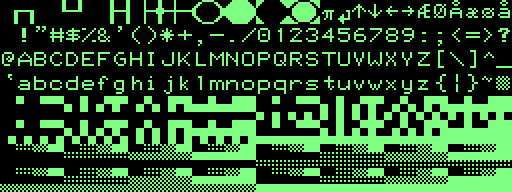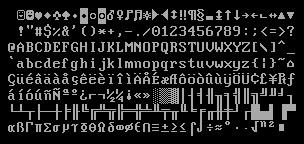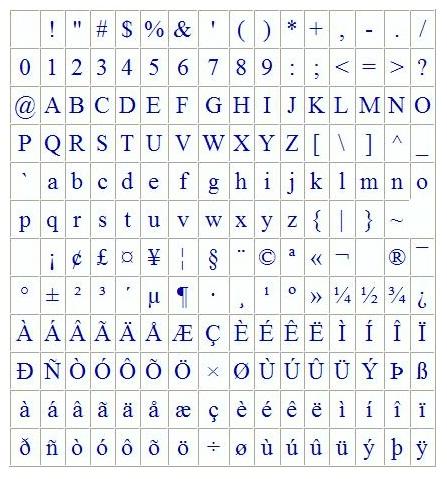Chapter 4 - Data Representation
4.1
Computers use Binary
Computers have circuits that are either on or off.
Each one of these is a bit. They are then organized in groups of eight and
called bytes. A computer's word size is when two or more bytes are
are addressed and manipulated collectively. The 8086 had a 16-bit word
size. The 80386 had a 32-bit word size. Now the x86 CPU's have
64-bit words.
Binary numbers can be tedious to work with. Hexadecimal provides a shorter
way to write binary with one hex digit representing four binary digits.
Programmers write hexadecimal numbers preceded with "0x" such as 0xFF for 255.
The reason for the 0 is so the compiler's parser doesn't mistake a hex number
for an identifier which begin with letters.
|
Decimal |
Binary 4-bit |
Hexadecimal |
| 0 |
0000 |
0 |
| 1 |
0001 |
1 |
| 2 |
0010 |
2 |
| 3 |
0011 |
3 |
| 4 |
0100 |
4 |
| 5 |
0101 |
5 |
| 6 |
0110 |
6 |
| 7 |
0111 |
7 |
| 8 |
1000 |
8 |
| 9 |
1001 |
9 |
| 10 |
1010 |
A |
| 11 |
1011 |
B |
| 12 |
1100 |
C |
| 13 |
1101 |
D |
| 14 |
1110 |
E |
| 15 |
1111 |
F |
|
As an example, colors are often specified using
three bytes. The bytes can be listed as either decimal or hex and
represent the amount of red, green, and blue in the color. Below
are some colors.
|
RGB Colors in Hex |
|
Red |
Green |
Blue |
Color |
| 00 |
00 |
00 |
black |
| FF |
FF |
FF |
white |
| FF |
00 |
00 |
red |
| 00 |
FF |
00 |
green |
| 00 |
00 |
FF |
blue |
| FF |
FF |
00 |
yellow |
| FF |
00 |
FF |
magenta |
| 80 |
80 |
80 |
gray |
| FF |
A5 |
00 |
orange |
|
To convert from binary to decimal, you can
add up the value of each of the 1's. Below is an example of how to convert
11010011 to decimal.
|
Binary Number |
1 |
1 |
0 |
1 |
0 |
0 |
1 |
1 |
128+64+16+2+1 = 211 |
|
Value of Each Digit |
128 |
64 |
32 |
16 |
8 |
4 |
2 |
1 |
4.2
Integers
Unsigned integers are stored in memory simply as the binary
representation of the number. A four byte unsigned integer will have a
maximum value of approximately 4.3 billion (232). Below are some examples.
|
Unsigned Integers |
|
Decimal |
Binary |
Hex |
| 2 |
00000000 00000000
00000000 00000010 |
00 00 00 02 |
| 255 |
00000000 00000000
00000000 11111111 |
00 00 00 FF |
| 8,388,608 |
00000000 10000000
00000000 00000000 |
00 80 00 00 |
| 4,294,967,295 |
11111111 11111111
11111111 11111111 |
FF FF FF FF |
Signed integers are can be stored in a variety of methods shown below.
1. Signed Magnitude uses the first bit to represent the sign and the rest
of the bits to represent the magnitude of the number. If the first bit is
0, the number is positive. If it is 1, the number is negative. A
four byte signed integer now only has 31 bits to hold the number giving a
maximum value of +2,147,483,647 and minimum value of -2,147,483,647.
One issue is that there are two ways to store the number zero. Below are
some examples.
|
Signed
Magnitude Integers |
|
Decimal |
Binary |
Hex |
| 3 |
00000000 00000000
00000000 00000011 |
00 00 00 03 |
| -3 |
10000000 00000000
00000000 00000011 |
80 00 00 03 |
| 0 |
00000000 00000000
00000000 00000000 |
00 00 00 00 |
| -0 |
10000000 00000000
00000000 00000000 |
80 00 00 00 |
| -65,535 |
10000000 00000000
11111111 11111111 |
80 00 FF FF |
2. One's Complement flips all the
bits to represent negative numbers. Below are some examples.
Wiki
|
One's Complement Integers |
|
Decimal |
Binary |
Hex |
| 7 |
00000000 00000000
00000000 00000111 |
00 00 00 07 |
| -7 |
11111111 11111111
11111111 11111000 |
FF FF FF F8 |
| 0 |
00000000 00000000
00000000 00000000 |
00 00 00 00 |
| -0 |
11111111 11111111
11111111 11111111 |
FF FF FF FF |
| 255 |
00000000 00000000
00000000 11111111 |
00 00 00 FF |
| -255 |
11111111 11111111
11111111 00000000 |
FF FF FF 00 |
One's complement has the advantage of
turning subtraction into addition. To subtract 7 from 255, take the one's
complement of 7 and add the two binary numbers. If there's a high-order
carry bit, remove it and add one to the answer.
|
One's Complement Subtraction |
|
Step |
Decimal |
Binary |
| To subract 7 from
255, add them after you make 7 negative using one's complement |
255
-7 |
00000000 00000000
00000000 11111111
11111111 11111111 11111111 11111000 |
| If there's a 1
high-order carry bit, add one to the answer |
247 |
1 00000000 00000000
00000000 11110111 |
| Answer is 248 |
248 |
00000000 00000000
00000000 11111000 |
2. Two's Complement creates negative
numbers by flipping all the bits (like one's complement) and adding 1. The
has the advantage of having only one representation for the number zero.
|
Two's
Complement Integers |
|
Decimal |
Binary |
Hex |
| 15 |
00000000 00000000
00000000 00001111 |
00 00 00 0F |
| -15 |
11111111 11111111
11111111 11110001 |
FF FF FF F1 |
| 0 |
00000000 00000000
00000000 00000000 |
00 00 00 00 |
| -1 |
11111111 11111111
11111111 11111111 |
FF FF FF FF |
| -2 |
11111111 11111111
11111111 11111110 |
FF FF FF FE |
| -255 |
11111111 11111111
11111111 00000001 |
FF FF FF 01 |
Two's complement subtraction is the same as one's
complement, but there is no need to add one if there's a carry bit.
|
Two's
Complement Subtraction |
|
Step |
Decimal |
Binary |
| To subract 2 from
15, add them after you make 2 negative using two's complement |
15
-2 |
00000000 00000000
00000000 00001111
11111111 11111111 11111111 11111110 |
| You can ignore the
carry bit |
13 |
1 00000000 00000000
00000000 00001101 |
C++ and Java use two's complement to store
negative integers. An int variable can store a number in the range
-2,147,483,648 to 2,147,483,647. A short int variable can store number in
the range -32,768 to 32,767. Negative integers can store one number higher
than positive since you add 1 to the number if it's negative.
3. Binary Coded Decimal (BCD) represents each digit of a decimal number
using 4 bits. For example, decimal 1942 is stored as 00011001 01000010.
|
1942 Stored as BCD |
| Decimal Digit: |
1 |
9 |
4 |
2 |
| 4-Bit Binary: |
0001 |
1001 |
0100 |
0010 |
4.3
Floating-Points
Single precision (32-bit) and double precision (64-bit) floating point numbers
are usually represented using the IEEE-754 standard. Below shows how the
bits are used in a single precision floating point.
|
Sign |
Exponent |
Mantissa |
|
1 bit |
8 bits |
23 bits |
Sign bit - 0 for positive and 1 for negative
Exponent - Use the exponent n where 2n is equal to the nearest
number equal or small than the number. For example, if the number is 17,
the exponent will be 4 since 24 = 16. This number is added to a
bias (127 for single precision). The bias is added because both
positive and negative exponents are needed. Negative exponents are needed
for fractions - e.g. 0.25 is 2-2. Using the bias allows for
simpler circuits in the CPU.
Mantissa (also called the significand) - This is the significant portion of the number. The decimal
point is moved so that the first 1 is removed. For example, if the number
is 19 (binary 10011), then the Mantissa will be 0011 with the remaining bits to
the right set
to 0. The number of places you move the decimal point is the same as the
exponent (before adding the bias). Fractions can get more complicated and
are only introduced here: 0.1 is equal to 1/2, 0.01 is equal to 1/4, 0.001
is equal to 1/8. Therefore, 4.5 is equal to 100.1
Example 1: How is 19 stored as a 32-bit floating point?
|
Sign |
Exponent |
Mantissa |
|
0 |
10000011 |
00110000000000000000000 |
|
0 for positive |
16 is nearest multiple of 2, so the exponent is 4.
This is added to 127 bias. |
19 is equal to 10011
The decimal point is moved to the left 4 places leaving 0011 after you
drop the 1. |
Example 2: How is 42.5 stored as a
32-bit floating point?
|
Sign |
Exponent |
Mantissa |
|
0 |
10000100 |
01010100000000000000000 |
|
0 for positive |
32 is nearest multiple of 2, so the exponent is 5.
This is added to 127 bias. |
42 is equal to 101010. For fractions, 0.1 =
1/2, 0.01 = 1/4, 0.001 = 1/8, etc.
Therefore 42.5 is equal to 101010.1
After you move the decimal point 5 places to the left, you have 010101 |
Here is an
online floating
point converter for practice. Here's another site with
conversion instructions.
4.4
Characters
To represent characters of the alphabet, a coding system is needed.
EBCDIC was created by IBM in for their System/360 mainframe computers in
1964. It was compatible with their peripheral equipment such as punch card
machines and teletypes.
ASCII (American Standard Code for Information Interchange) was developed
in the 1960's by the American Standard's Association and promoted by Bell data
services. It is a descendant of a 5-bit
Baudot telegraph code
from the 1870's created by Emile Baudot. The original ASCII code used
7-bits giving 128 different characters and control codes. The 8th bit
could be used as a parity bit. Parity is used for detecting errors during
data transmission. Traditionally, phone lines could have static causing
some bits to be lost. The parity bit is set to the even or odd depending
on the sum of the other bits. For example, to transmit the letter "a" in
7-bit ASCII you have decimal 97 which is 1100001. Since the sum of the 1's
is odd, the 8th bit is set to 1 (11100001).
|
7-bit ASCII Chart |
0
NUL
1 SOH - start of heading
2 STX - start of text
3 ETX - end of text
4 EOT - end of transmssn
5 ENQ - enquiry
6 ACK - acknowledge
7 BEL - bell (beep)
8 BS - backspace
9 HT - horizontal tab
10 LF - line feed
11 VT - vertical tab
12 FF - form feed
13 CR - carriage return
14 SO - shift out
15 SI - shift in |
16
DLE - data line escape
17 DC1 - device control 1
18 DC2 - device control 2
19 DC3 - device control 3
20 DC4 - device control 4
21 NAK - negative ACK
22 SYN - syncrhonous idle
23 ETB - end transm block
24 CAN - cancel
25 EM - end of medium
26 SUB - substitute
27 ESC - escape
28 FS - file separator
29 GS - group separator
30 RS - record separator
31 US - unit separator |
32
space
33 !
34 "
35 #
36 $
37 %
38 &
39 '
40 (
41 )
42 *
43 +
44 ,
45 -
46 .
47 / |
48
0
49 1
50 2
51 3
52 4
53 5
54 6
55 7
56 8
57 9
58 :
59 ;
60 <
61 =
62 >
63 ? |
64
@
65 A
66 B
67 C
68 D
69 E
70 F
71 G
72 H
73 I
74 J
75 K
76 L
77 M
78 N
79 O |
80
P
81 Q
82 R
83 S
84 T
85 U
86 V
87 W
88 X
89 Y
90 Z
91 [
92 \
93 ]
94 ^
95 _ |
96
`
97 a
98 b
99 c
100 d
101 e
102 f
103 g
104 h
105 i
106 j
107 k
108 l
109 m
110 n
111 o |
112
p
113 q
114 r
115 s
116 t
117 u
118 v
119 w
120 x
121 y
122 z
123 {
124 |
125 }
126 ~
127 DEL |
The control codes (0 - 31) were for telegraph and
teletypes and are no longer used except for 10 (line feed or \n) and 27
(escape).
|
Extended ASCII
Eventually, the 8th bit is became used to extend the ASCII character set
to 256. The TRS-80 used the extra bit to create blocks for low
resolution graphics. The IBM PC replaced the control characters
with symbols like smiley faces and the extended characters were lines
for drawing boxes and Greek symbols. Other companies created their
own extended ASCII character set. It can cause confusion when
looking at data or running programs encoded with a different version of
the extended ASCII set.

TRS-80 extended ASCII

IBM PC DOS extended ASCII |

Latin-1 extended ASCIIThe
most popular extended ASCII character set used is today is referred to
as Latin-1. It has Latin characters for most Western European
languages.
|
Unicode
was created to add all the characters used in most of the world's written
languages. Here are two sites where you can see the Unicode character
sets: jgraphix.net
unicode-table.com The Unicode
character set uses 2 bytes giving 65536 different characters. The UTF-8 encoding specification allows each
character to be one to four bytes. This allows it backwards compatible
with ASCII. UTF-8 is a popular encoding for today's web pages.


